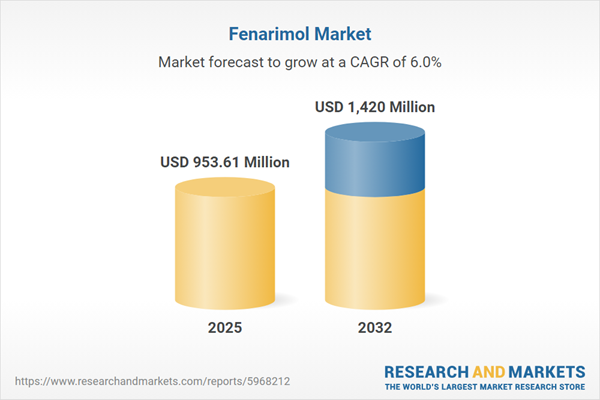Speak directly to the analyst to clarify any post sales queries you may have.
Fenarimol is a systemic fungicide essential to global agriculture's evolution, enabling more resilient and sustainable crop production. Senior leaders in agribusiness, agrochemical manufacturing, and distribution benefit from understanding how shifting regulations, new technologies, and changing trade conditions are reshaping the fenarimol market.
Market Snapshot: Fenarimol Market Size and Growth Trajectory
The fenarimol market grew from USD 899.86 million in 2024 to USD 953.61 million in 2025, driven by broad-spectrum disease control solutions. With a projected compound annual growth rate (CAGR) of 5.95%, the sector is expected to reach USD 1.42 billion by 2032, fueled by enduring need for effective crop protection and emerging regulatory focus on sustainable agrochemicals.
Scope & Segmentation of the Fenarimol Market
- Crop Type: Cereals and grains (barley, corn, rice, wheat); fruits and vegetables (grapes, potato, tomato); oilseeds and pulses (chickpea, lentil, peanut, soybean).
- Formulation Type: Emulsifiable concentrate, granule, suspension concentrate, wettable powder.
- Route of Administration: Foliar spray (airblast, high volume, mist blower), seed treatment, soil treatments (drench, incorporation), trunk injection.
- End Use Industry: Agriculture, industrial water treatment (boiler systems, cooling towers), livestock and aquaculture (dairy, fish farms, poultry), pharmaceutical and personal care (cosmetics, human pharma, veterinary pharma).
- Sales Channel: Dealer sales, direct sales (corporate interaction, field sales, key account management), distributors (national, regional), online retail (e-commerce platforms, manufacturer websites).
- Regional Coverage: Americas (United States, Canada, Mexico, Brazil, Argentina, Chile, Colombia, Peru), Europe, Middle East & Africa (United Kingdom, Germany, France, Russia, Italy, Spain, Netherlands, Sweden, Poland, Switzerland, United Arab Emirates, Saudi Arabia, Qatar, Turkey, Israel, South Africa, Nigeria, Egypt, Kenya), Asia-Pacific (China, India, Japan, Australia, South Korea, Indonesia, Thailand, Malaysia, Singapore, Taiwan).
- Companies Analyzed: Syngenta AG, Bayer AG, BASF SE, Corteva, FMC Corporation, UPL Limited, ADAMA Agricultural Solutions, Sumitomo Chemical, Nufarm, Sipcam-Otirfia S.p.A.
Key Takeaways for Senior Decision-Makers
- The fenarimol market’s evolution is shaped by stringent environmental regulations and a growing preference for sustainable fungicide technologies, prompting innovation in both formulation and application methods.
- Companies that prioritize flexible routes of administration and invest in customized solutions for grains, fruit crops, and oilseeds are positioned for segment-driven growth.
- Digital agriculture tools and real-time crop monitoring platforms are enabling more targeted and efficient application of fenarimol, supporting operational efficiency and environmental compliance objectives.
- Emerging regional trends—such as precision application of foliar sprays in the Americas, trunk injection uptake in EMEA, and tailored formulations for Asia-Pacific’s humid and diverse conditions—reflect the importance of localized strategies.
- Strategic partnerships, especially with regional distributors and through innovation alliances, are supporting market penetration and driving technology adoption across all key end use industries.
Tariff Impact: Navigating U.S. Agrochemical Trade Barriers
The implementation of increased U.S. tariffs in 2025 has introduced significant cost and supply challenges for fenarimol, influencing procurement decisions and accelerating the need for local sourcing and adaptive supply chain models. Distributors and manufacturers are adopting new strategies—such as local manufacturing partnerships and diversified sourcing—to respond to trade volatility and assure supply stability. These tariff-driven trends demand agile risk management and proactive collaboration across the value chain.
Methodology & Data Sources
This analysis draws on structured interviews with agronomists, crop protection experts, distributors, and end users in core regions. Secondary research incorporates scientific studies, industry reports, regulatory filings, and trade journals. Triangulation of primary and quantitative data, supported by stakeholder workshops, reinforces the credibility and depth of insights.
Why This Report Matters for B2B Leaders
- Enables effective resource allocation and product planning aligned with regulatory shifts and technological advancements.
- Reveals actionable trends in regional adoption, distribution models, and competitive positioning within the fenarimol market.
Executives benefit from these data-backed forecasts to navigate tariff challenges, strengthen sustainability strategies, and drive resilient business growth.
Conclusion
The fenarimol market is being shaped by sustainability imperatives, innovation in formulations, and adaptive business strategies. Companies committed to technology integration and collaborative alliances are well placed to succeed in this evolving landscape.
Additional Product Information:
- Purchase of this report includes 1 year online access with quarterly updates.
- This report can be updated on request. Please contact our Customer Experience team using the Ask a Question widget on our website.
Table of Contents
3. Executive Summary
4. Market Overview
7. Cumulative Impact of Artificial Intelligence 2025
Companies Mentioned
The companies profiled in this Fenarimol market report include:- Syngenta AG
- Bayer AG
- BASF SE
- Corteva, Inc.
- FMC Corporation
- UPL Limited
- ADAMA Agricultural Solutions Ltd
- Sumitomo Chemical Co., Ltd.
- Nufarm Limited
- Sipcam-Otirfia S.p.A.
Table Information
| Report Attribute | Details |
|---|---|
| No. of Pages | 188 |
| Published | October 2025 |
| Forecast Period | 2025 - 2032 |
| Estimated Market Value ( USD | $ 953.61 Million |
| Forecasted Market Value ( USD | $ 1420 Million |
| Compound Annual Growth Rate | 5.9% |
| Regions Covered | Global |
| No. of Companies Mentioned | 11 |









